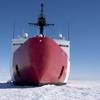NOAA's 15-Year Plan to Invest in Ships
NOAA has completed a detailed plan to modernize its marine operations
by replacing nine research ships and refurbishing a tenth in the next
15 years.
“Sea-going vessels are a key source of observational data used by NOAA
scientists. A modern, more capable fleet will ensure we can meet the
ever changing demands of the science community,” said retired Navy
Vice Admiral Conrad C. Lautenbacher, Jr., Ph.D., under secretary of
commerce for oceans and atmosphere and NOAA administrator. “When I
arrived at NOAA in 2001, the average age of our fleet was 32 years.
Today, it is 27, and at the end of this ambitious program the age will
drop to 17.”
NOAA’s Office of Marine and Aviation Operations conducted an
assessment of the 19 ships in the fleet, and determined that 10 of
those vessels will reach the end of their useful service life over the
next 15 years. The fleet replacement plan is a comprehensive program
to systematically replace or upgrade the fleet.
The fleet supports a wide range of marine activities, including
fisheries and coastal research, nautical charting, and long-range
ocean and climate studies. NOAA's ships are specially equipped and
designed to support the agency's programs, and have some capabilities
not found in the commercial fleet.
Nine vessels have entered into service since 2001 including Okeanos
Explorer, the first NOAA vessel solely dedicated to ocean exploration,
on Aug. 13. Two additional ships are scheduled to enter service within
the next year: Pisces, which will be homeported in , and
Bell M. Shimada, which will be homeported on the West Coast.
The NOAA fleet is managed, operated and maintained by NOAA’s Office of
Marine and Aviation Operations. This office is composed of officers of
the NOAA Corps, a uniformed service of the , and civilian
personnel.










